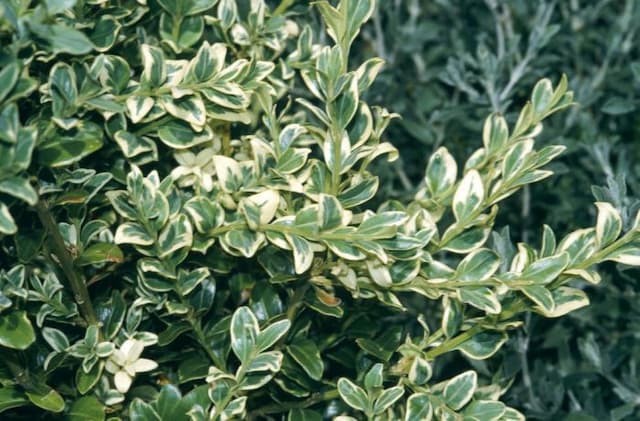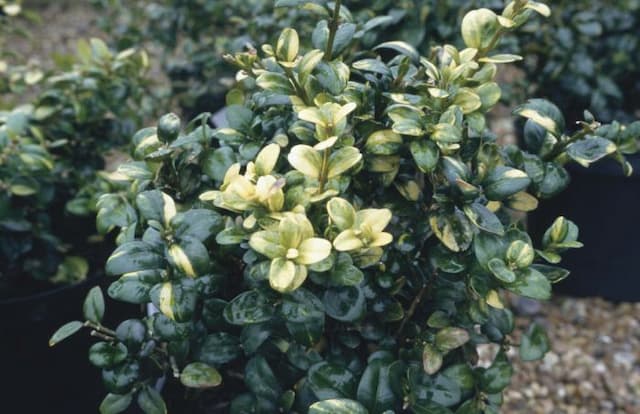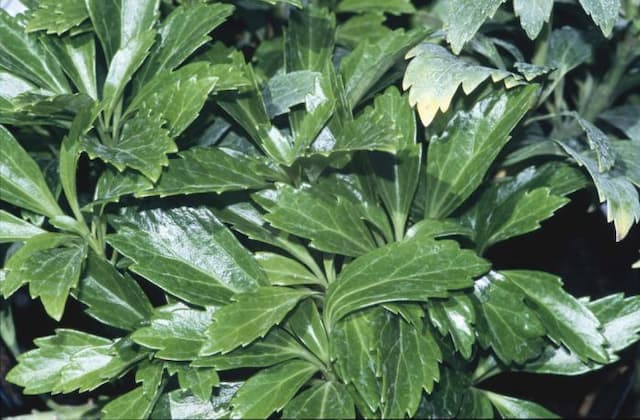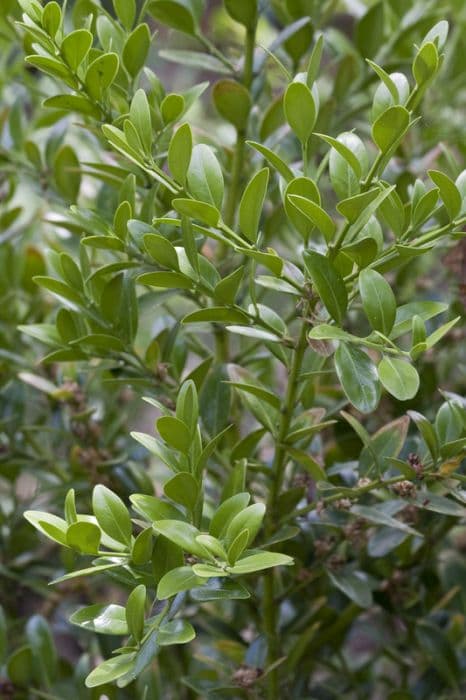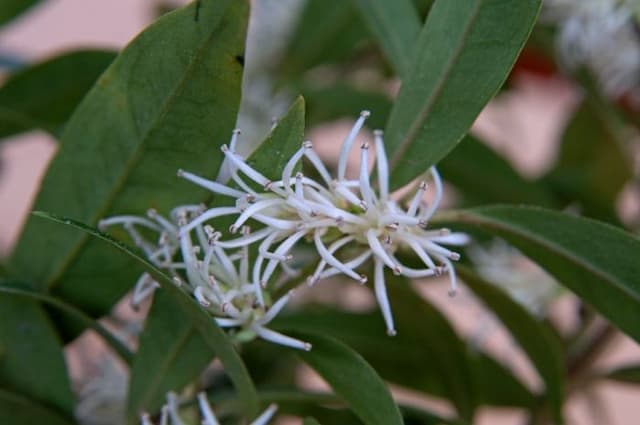Sweet Box Sarcococca orientalis

ABOUT
Sarcococca orientalis, commonly known as Sweet Box or Oriental Sweet Box, is an evergreen shrub with a dense bushy habit. It is characterized by its glossy, dark green leaves that are lance-shaped and pointed at the tips. The foliage has a leathery texture and is arranged alternately along the stems, providing year-round visual interest. During the late winter to early spring, Sweet Box blooms with small, creamy-white flowers that are somewhat inconspicuous but highly fragrant. The scent of these blossoms can fill the surrounding air and is one of the plant's most delightful features. After flowering, the plant often produces berry-like fruits that typically mature to a glossy black, adding another layer of interest to the plant’s appearance. Overall, the appearance of Sweet Box is lush and attractive, with a refined look that makes it suitable for use in various landscape settings such as foundation plantings, borders, or as a low hedge. Its ability to thrive in shady conditions, coupled with its fragrant flowers and glossy evergreen leaves, make it a favored choice for gardeners looking to add both beauty and aroma to their gardens.
About this plant
 Names
NamesFamily
Buxaceae
Synonyms
Oriental Sweet Box, Oriental Sarcococca
Common names
Sarcococca orientalis
 Toxicity
ToxicityTo humans
Sarcococca orientalis, commonly known as Sweetbox, is not known to be highly toxic to humans. However, like many plants, it may cause mild discomfort if ingested, leading to symptoms such as nausea, vomiting, or diarrhea. It's essential to teach children not to eat any parts of ornamental plants due to the potential risk of unknown toxicities.
To pets
Sweetbox is not commonly listed as a toxic plant to pets such as dogs and cats. However, it is generally advisable to prevent pets from ingesting plants. If a pet does consume parts of a Sweetbox plant, it may experience mild gastrointestinal upset, including symptoms like vomiting or diarrhea. If you suspect your pet has ingested a significant amount of the plant and is showing symptoms, consult a veterinarian.
 Characteristics
CharacteristicsLife cycle
Perennials
Foliage type
Evergreen
Color of leaves
Dark green
Flower color
White
Height
3-5 feet (0.91-1.52 meters)
Spread
2-4 feet (0.61-1.22 meters)
Plant type
Shrub
Hardiness zones
7
Native area
China
Benefits
 General Benefits
General Benefits- Year-round interest: Sarcococca orientalis, commonly known as Sweet Box, has evergreen foliage that maintains garden interest throughout the year.
- Fragrant flowers: The small, white, highly-perfumed flowers bloom in winter, providing a sweet fragrance when few other plants are flowering.
- Shade tolerance: Sweet Box is well-suited for shaded areas where many other plants might struggle to grow.
- Low maintenance: Once established, this plant requires minimal care, making it ideal for gardeners seeking low-maintenance landscaping options.
- Drought resistance: It is relatively drought-resistant, making it suitable for dry shade gardens once it is well established.
- Wildlife habitat: Provides food and shelter for various insects and birds, thus contributing to local biodiversity.
- Compact growth: Its compact and slowly spreading habit makes it a good choice for small gardens and borders without the risk of it becoming invasive.
- Ground cover: The dense foliage can serve as an effective ground cover, suppressing weeds and minimizing soil erosion.
- Ornamental berries: After flowering, it produces ornamental black berries that add visual interest during late summer and autumn.
- Versatile landscaping: Can be used in a variety of garden settings, including containers, borders, and as an understory plant in woodland gardens.
 Medical Properties
Medical PropertiesThis plant is not used for medical purposes.
 Air-purifying Qualities
Air-purifying QualitiesThis plant is not specifically known for air purifying qualities.
 Other Uses
Other Uses- Natural Dye: The berries of Sarcococca orientalis may be used to create a natural dye for textiles, giving them a subtle color.
- Privacy Screening: Due to its dense foliage, it is often planted as a privacy screen in gardens and parks.
- Essential Oils: The plant may be used in the production of essential oils for use in fragrances, though it is not a common source for this purpose.
- Ground Cover: Because of its low-growing habit, it can be utilized as ground cover to prevent soil erosion in shaded areas.
- Winter Garden Interest: Its evergreen leaves and winter-blooming flowers add aesthetic value to gardens during the dull winter months.
- Habitat Creation: It provides shelter and food for small wildlife, especially beneficial insects during the flowering season.
- Floral Arrangements: The flowers and foliage can be used in floral arrangements, particularly in winter when other flowers might be scarce.
- Sound Barrier: When planted in mass, Sarcococca orientalis can reduce noise pollution due to its dense growth.
- Windbreaks: It can be planted in a row to act as a shield against wind, especially in coastal or exposed areas.
- Meditative Gardens: Its subtle fragrance and evergreen nature make it suitable for planting in meditative or sensory gardens.
Interesting Facts
 Feng Shui
Feng ShuiThe Sweet Box is not used in Feng Shui practice.
 Zodiac Sign Compitability
Zodiac Sign CompitabilityThe Sweet Box is not used in astrology practice.
 Plant Symbolism
Plant Symbolism- Endurance: Sarcococca orientalis, commonly known as Sweet Box, is a tough plant that can thrive in challenging conditions, symbolizing the ability to endure and persist through adversity.
- Protection: Sweet Box has robust evergreen foliage which is believed to symbolize protection and shelter against negative forces.
- Renewal: Blooming in the depths of winter, Sweet Box represents renewal and the promise of new beginnings.
- Hope: The fragrant flowers of Sweet Box release a sweet scent even in the cold winter air, representing hope and optimism during dark times.
- Purity: The delicate, white flowers of Sweet Box are often associated with purity and innocence.
 Water
WaterSweetbox prefers consistent moisture and should be watered approximately once a week, allowing the soil to slightly dry out between waterings. During the growing season, in the absence of rainfall, provide about 1 gallon of water per week to a mature plant, depending on climate and soil conditions. Less water may be needed during the winter months when the plant is not actively growing. It's important to avoid overwatering as this can lead to root rot. Ensure the plant is in well-draining soil to prevent water from pooling around the roots.
 Light
LightSweetbox thrives best in partial to full shade, preferring indirect light or dappled sunlight. It is well-suited for planting under larger trees or on the north side of a building, where it can be protected from the harsh afternoon sun. Avoid placing it in an area that receives prolonged periods of direct sunlight, especially in hotter climates.
 Temperature
TemperatureSweetbox is hardy and can tolerate a range of temperatures, growing well in temperatures ranging from 10°F to 90°F. The ideal temperature for Sweetbox is between 60°F and 75°F. This plant can survive brief periods of colder winter temperatures but should be protected from harsh, freezing winds.
 Pruning
PruningSweetbox should be pruned to maintain its shape and to remove any damaged or diseased branches. Pruning is best done after flowering in late winter or early spring. Prune as needed to keep the desired size and shape, which may be once per year for light maintenance. It's also a good time to remove any dead wood and thin out over-crowded branches to improve air circulation.
 Cleaning
CleaningAs needed
 Soil
SoilSweet Box prefers rich, well-draining soil with a slightly acidic to neutral pH, around 6.0 to 7.0. A mix of peat, pine bark, and perlite or sand works well for maintaining moisture while allowing excess water to drain.
 Repotting
RepottingSweet Box should be repotted every 2 to 3 years or when it becomes root-bound. Spring is the best time for repotting this plant to allow for growth during its active season.
 Humidity & Misting
Humidity & MistingSweet Box thrives in average to high humidity levels. To maintain ideal conditions, aim for 40-60% humidity which is common in household environments.
 Suitable locations
Suitable locationsIndoor
Place Sweet Box in bright, indirect light; keep soil consistently moist.
Outdoor
Plant Sweet Box in partial shade; protect from harsh sun and wind.
Hardiness zone
7-9 USDA
 Life cycle
Life cycleSarcococca orientalis, commonly known as Sweet Box, begins its life cycle with seed germination, where the seed swells and splits allowing the radicle to grow downward to form the root system. Seedling development follows, characterized by the emergence of the plant’s first leaves and continued root growth. This progresses to the juvenile phase, where the plant is actively growing but not ready to flower, focusing on establishing a strong vegetative structure. Once mature, Sweet Box enters the reproductive stage when it produces small, fragrant flowers that are typically white or pale pink, leading to pollination and fertilization. Following successful fertilization, the plant develops fruits – small, often shiny berries that mature on the plant. These berries contain seeds that, once dispersed, begin a new lifecycle.
 Propogation
PropogationPropogation time
Late winter-early spring
Propogation: Sarcococca orientalis, commonly known as Sweet Box, is typically propagated through semi-hardwood cuttings. The optimal time for taking cuttings is in the summer when the current year's growth has started to mature but isn't fully hardened. To propagate by cuttings, one would cut a semi-hardwood stem of about 4 to 6 inches (approximately 10 to 15 cm) in length, making sure it has a few leaves. The bottom end of the cutting should be dipped in rooting hormone to encourage root development and then planted in a mixture of half perlite and half peat. The cutting should be kept in a warm, shaded area and maintain a consistent moisture level in the soil without letting it become waterlogged. Rooting typically occurs within several weeks to a few months, after which the new plants can be transplanted.

